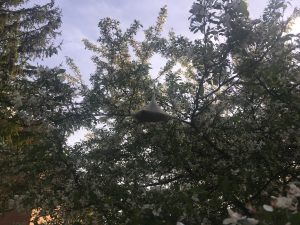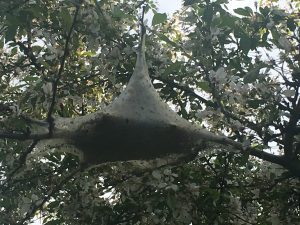Dear esteemed fellow nature enthusiasts,
Last Thursday, as I was running on two hours of sleep due to a poorly timed #sunrike, I managed to spot-RIGHT after we discussed these critters in class, what a coincidence-a colony of tent worms basking in the glory of Green Key in the blossoming trees near my residential hall.
They were just as scary as I remembered them from my days of youth when I would accidentally stumble upon one of their nests during a game of hide and seek: their beady eyes stared at me, and I ran away before snapping a photo to document that I had seen them.
Tonight, I returned to face my fear: at 6:53 pm EST, I scrambled up the hillside near Burke Chemistry building and frantically took two photos before cringing in fear and rushing off to my Movement Against Violence meeting (join in the fall! we welcome new members!).
After cowardly retreating, I conducted some brief research on the tent worms and it turns out that they are in fact caterpillars (soon-to-be-moths) that use the tent as a home base for their expeditions to forage for food until they are ready and available to transition into their final cycle of life (mothdom, a word I just made up for the state of being a moth) before ultimately dying. They are able to leave the tent itself through small holes at the branch junctures. The most interesting thing about these silk-tent-dwelling caterpillars is that they leave a chemical trail when they leave their nest in order to allow themselves to find their way back to their home. After eight weeks, the caterpillars develop into moths, who only serve to repeat this cycle of terror.
As a side note, conducting this very preliminary research caused my skin to crawl due to the sheer number of terrifying photos available of the tent caterpillar. If one of our faithful readers chooses to conduct more research into this species (which I believe is the Eastern tent caterpillar), please exercise caution. I’m warning you, these caterpillars are scary on film.
Once again, this PSA was brought to you by AYP.
Source:
T.Fitzgerald. “Eastern Tent Caterpillar.” Eastern Tent Caterpillar. University of Cortland, n.d. Web. 23 May 2017. <http://facultyweb.cortland.edu/fitzgerald/Easterntent.htm>.



